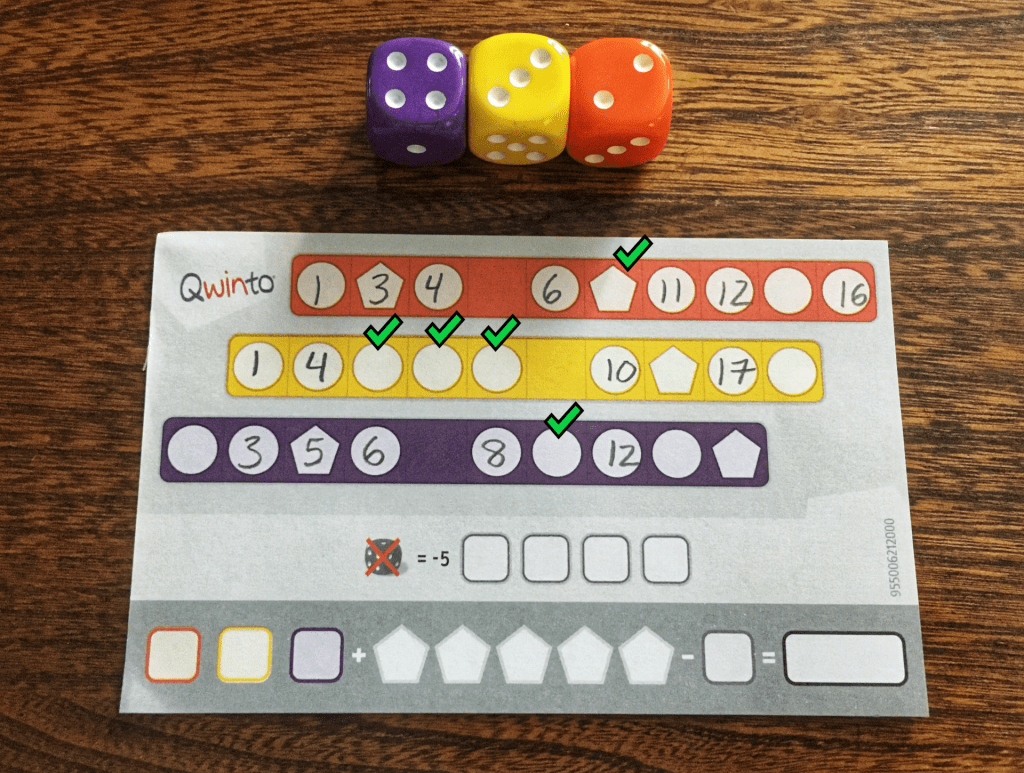Disclosure: Meeple Mountain received a free copy of this product in exchange for an honest, unbiased review. This review is not intended to be an endorsement.
Qwinto, an official Spiel des Jahres recommended game and the spiritual successor to Qwixx, is a quick-playing, abstract roll and write game. If you’ve played Qwixx before, some of the mechanisms in Qwinto will feel familiar, but there is certainly more depth to Qwinto than its predecessor.
In the game, the active player rolls between 1 and 3 coloured dice. Then they will have the chance to write the result somewhere on their scoresheet. The other players may also write the value rolled on their sheet. All of this is done with the goal of writing the most numbers in all 3 rows. While the gameplay sounds simple in theory, the way rows and columns are scored, along with the decisions you must make as the active player, make Qwinto qwite the tricky game. (Sorry, I couldn’t resist.)
Let’s take a few minutes to dive deeper into how a game of Qwinto is played.

How to Play Qwinto
Qwinto is one of those roll and write games where every player is always engaged. When it’s your turn, you — as the active player — roll dice, but then all players (including you) have the opportunity to use the result of your roll.
Decisions, Decisions
As the active player, you begin your turn by deciding how many dice to roll (1, 2, or 3) and which colour these dice will be. Then you roll the die/dice (for simplicity’s sake, I’m going to stick with using the term “dice” going forward, but know that everything still applies if you use a single die). If you’re happy with your roll, wonderful; if you’re dissatisfied you may re-roll, but you must re-roll all the dice you initially chose. If you’re unhappy with this second roll, tough luck. You must keep the result of whatever you rolled on your second attempt.

Next, call out the sum of the dice you rolled and all players may then write this number in one field on their scoresheet in a coloured row that matches a colour on the dice rolled. Within a column, no number may appear more than once. When entering numbers in a row, they can be written in any field provided that:
- the numbers in the row are in ascending order (but not necessarily sequential) and
- there can be no repeating numbers.

The active player must write the number in a field if they don’t want to incur a penalty; the other players have the option to choose not to with no penalty. If the active player cannot (or does not want) to enter a number, they mark the failed attempt on their scoresheet and will lose 5 points at the end of the game.
After this the next player in clockwise order becomes the active player. This sequence of play continues until the game ends — when either one player has filled all fields in 2 rows or one player has all their “failed attempt” boxes checked off.
Scoring
At the end of the game, players evaluate each of their coloured rows. For each row that has empty spaces players score 1 point for each field with a number written in it. If there are no empty spaces, they score points equal to the number written on the far right (i.e. the row’s largest number).

Next, each player looks at the 5 columns with three fields to see if they score any bonus points: for each completed column, the player scores points equal to the number written in the pentagon in that column.

Then players deduct 5 points for each of their failed attempts. (In the example above, the player would lose 20 points.) The player with the most points wins.
Final Thoughts
Qwinto looks deceivingly simple; with a small box filled with very few components and deemed the follow-up to the Spiel des Jahres nominated game Qwixx, it’s easy to dismiss this game as “too light” and not worth your attention. Ultimately I feel the comparison to Qwixx does Qwinto a disservice. That isn’t to say that Qwixx is a bad game, but it is on the lighter end of the roll and write genre; in it, players simply check off numbers in ascending or descending coloured rows. While Qwinto does expand on this original mechanism, the new additions to the game add much more depth and strategy to gameplay, making games of Qwinto much crunchier than any game of Qwixx I’ve ever played.
This is because there is a lot to consider on your turn — both as the active player and as an inactive player. Of course, when you are adding numbers to the rows on your scoresheet you must consider your legal placement options, but then you must also think about how to best add the number so that you aren’t backing yourself into a corner — that is if you even decide to add the number at all. Some numbers might work really well in a certain colour’s row, but then they would limit your options to fill in another coloured row or complete a column to score. Ideally you want high numbers in the pentagons to score columns, but that isn’t always feasible, especially when a pentagon is near the start of a row.
As the active player, you have even more to consider. How many dice do you roll and how much are you willing to risk incurring a penalty just to try for a really high sum? Which colours do you roll and how will that affect the probability that you’ll roll the numbers that you need? And, not to mention, the decisions you make will also affect the other players — who have everything to gain, but nothing to lose if you fail. All of these gameplay decisions packed into a tiny box with just a few components.
I like Qwixx, but I really like Qwinto. I appreciate the player interaction because it means you’re always engaged in the gameplay and often anxiously awaiting the result of your opponent’s roll. I particularly like that only the active player gets punished for rolling a number they can’t use because it eliminates any direct take-that in the game (although players can certainly be more passively aggressive by choosing dice they know other players can’t use). With Qwinto, I dig the considerations you need to make on your turn — especially as the active player — and all the interesting little subtleties that add an extra layer of strategy to the gameplay.
If you’re not a fan of roll and write games, especially heavier abstract ones like Ganz schön clever, Qwinto isn’t a game that I would recommend seeking out. However, if you’re a fan of the genre, Qwinto is a real winner; I know you’ll love the qwick, qwirky, qwality gameplay of Qwinto just as much as I do.












Add Comment